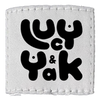Ah lovely linen. I just love the way it looks (except when it gets all creased, which is definitely a downside!), how it feels, how cool and comfortable it is. Turns out it is also really quite a good option in terms of environmental impact and sustainability.
The process
It is quite an expensive fabric and looking into the process of turning stalk into cloth, reveals why. Linen is made from the flax plant, a vigourous plant which grows best in cool, humid climates. It likes moist soil so there is a water use implication. But like hemp it doesn't really need pesticides to grow; it is hardy enough and grows well enough without to make organic linen a great option. However, it does need careful tending. It's important to remove weeds from around the plants otherwise the flax can be swamped. The flax plant produces white or blue flowers; the blue flowered plants make the highest quality linen.
The tricky bit of the process is the separation of the flax fibres from the woody stem. In some places this is still done by hand. In fact, before the industrial revolution some people think linen was the most important fabric in the world. These days the highest quality linen still comes from Belgium, although Scottish linen is also highly prized. When European settlers first went to America they planted small plots of flax for linen, but soon abandoned it in favour of cotton. Now almost all linen used in America is imported.
The separation process is called “retting” and can be done mechanically or through the use of chemicals. Obviously, the former is more environmentally friendly but adds an additional challenge. Apparently linen that has been hand-retted can be very smelly, perhaps because essentially the retting process is about getting the bits of the stalk that you don't want to rot away, and without the use of chemicals that process is slower and therefore smellier. I would think that by the time the linen has been spun, washed and possibly also dyed this would be less of a problem.
Why it's so good
There's an unexpected advantage with linen that I had no idea about. Every part of the plant can be used for something, so there can be no wastage. As well as fibre, flax can be used to make linseed oil, the seeds are edible and nutritious and the sprouts are also edible and slightly spicy. The byproduct of producing linseed oil from flax seeds is used to feed animals, It's also used to make bank notes, cigarette paper and tea bags. The latin name for linen is “usitatissimum” which means “most useful”.
As with other natural fibres another big advantage is that it is biodegradable. When we wash our clothes, fibres are released and flushed into the drains. With natural fabrics this is mostly natural fibres which don't cause any problems as they biodegrade, releasing their nutrients back into the eco system. As we will discuss later, this is a problem with synthetic fibres. But for linen it's another in a long list of advantages.
I'm finding it fascinating learning more about different fabrics. Linen is getting close to the top of my list of favourites. Hope you're enjoying this series too.

